高中英语语法形容词和副词讲解
高中英语语法系列――形容词和副词

高中英语语法系列――形容词和副词[知识梳理]一、形容词的概念与用法形容词(adjective)用以修饰名词,表示人或事物的特征。
它可在句中充当定语,修饰名词、代词;可以作表语或宾(主)语的补足语,表示主语或宾语的状态、特征;有时也可以作状语。
如:This is a beautiful school.这是一所美丽的学校。
(作定语,修饰名词school)I have something important to tell you.我有些重要的事要告诉你们。
(作定语,修饰不定代词something)Our school is beautiful.我们学校很美丽。
(作表语)We’ll make our school more beautiful.我们要使我们的学校更美丽。
(作宾补)Our school will be made more beautiful.我们的学校将会变得更美丽。
(作主补)He got home late that night, hungry and tired.那天晚上他很迟才回来,又累又饿。
(作状语)二、副词的概念与用法副词(adverb)用以修饰动词、形容词或其它副词。
它在句中主要作状语,个别副词也可作表语、定语、或宾(主)语补足语。
He studies hard.他学习很努力。
(作状语,修饰动词)I’m terribly sorry for being late. 非常抱歉,我迟到了。
(作状语,修饰形容词)This coat fits him very well.这件上衣他穿着很合适。
(作状语,修饰副词)The people here are kind to us.这里的人对我们很好。
(作定语,修饰The people)When will you be back? 你什么时候回来?(作表语)三、形容词与副词的转换有的形容词加上ly后可转换成副词,规则如下:注意:friendly, motherly, lovely等词虽然以ly结尾,但不是副词,而是形容词。
高中英语语法讲义——形容词与副词
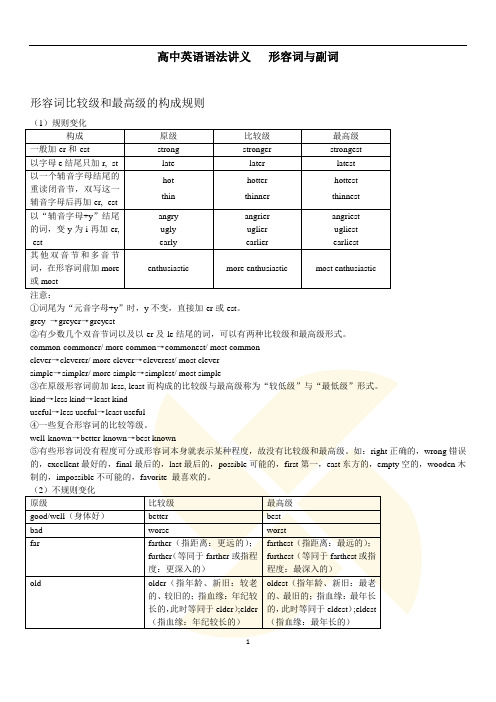
高中英语语法讲义形容词与副词形容词比较级和最高级的构成规则构成原级比较级最高级一般加-er和-est strong stronger strongest 以字母e结尾只加-r, -st late later latest以一个辅音字母结尾的重读闭音节,双写这一辅音字母后再加-er, -est hotthinhotterthinnerhottestthinnest以“辅音字母+y”结尾的词,变y为i再加-er, -est angryuglyearlyangrieruglierearlierangriestugliestearliest其他双音节和多音节词,在形容词前加more或mostenthusiastic more enthusiastic most enthusiastic①词尾为“元音字母+y”时,y不变,直接加-er或-est。
grey →greyer→greyest②有少数几个双音节词以及以-er及-le结尾的词,可以有两种比较级和最高级形式。
common-commoner/ more common→commonest/ most commonclever→cleverer/ more clever→cleverest/ most cleversimple→simpler/ more simple→simplest/ most simple③在原级形容词前加less, least而构成的比较级与最高级称为“较低级”与“最低级”形式。
kind→less kind→least kinduseful→less useful→least useful④一些复合形容词的比较等级。
well-known→better-known→best known⑤有些形容词没有程度可分或形容词本身就表示某种程度,故没有比较级和最高级。
如:right正确的,wrong错误的,excellent最好的,final最后的,last最后的,possible可能的,first第一,east东方的,empty空的,wooden木制的,impossible不可能的,favorite 最喜欢的。
高中英语语法形容词和副词

2. 几种变化形式: as much + 不可数名词 + as There is as much water in this bottle as in that one. as many +可数名词复数 + as
Bob has read as many books as Mary.
as + 形容词 + 不定冠词 + 可数名词单数 + as German is as difficult a language as Chinese. as + 形容词 + 不可数名词 + as Bread is as important food as rice.
4. 作状语
It’s raining heavily.
It’s a rather interesting job.
This is just what I said.
Eventually he arrived in Beijing.
注意:1. 有些副词有两种形式,一种与形容词同形,一 种以ly结尾,但它们的含义不同。 The station is quite near. He lives near.
后置定语: 少数以a开头的形容词(absent, alike, alive, available) 及 其他形容词(concerned, present) 作定语时后置。 He made full use of English reference books available and learned a lot. People concerned will attend the meeting.
“as+形容词+(a/an)+名词+as”表示同级比较,注 意中间的形容词和名词并列时各自所在的位置。 It is generally believed that teaching is as much an art as it is a science.
高中英语:形容词与副词语法知识点

高中英语:形容词与副词语法知识点一、形容词、副词的等级(一)形容词/副词的比较级和最高级构成1.规则形容词级的构成大多数形容词、副词有三种形式: 原级、比较级和最高级。
原级用形容词/副词的原形。
它们的比较级和最高级规则变化如下表:2.不规则形容词的级的构成3.形容词、副词递减的比较等级的构成在形容词、副词前加less和least,表示“较不”和“最不”interesting有趣的 less interesting较无趣的 least interesting最无趣的important重要的 less important较不重要的 least important最不重要的有些形容詞可以加er及est或前面加上more / most來形成比較級和最高級polite –politer 或more polite –politest 或most polite ,这类词还有quiet,handsome,pleasant,common,exact.注意:下列双音节词比较级和最高级加er;est(1).无规律,死记住的词cruel,pleasant quiet civil exact stupid commom,dismal(阴沉的,忧郁的), devine(梦幻的) antique(古老的) grotesque(怪诞的)(2)-le以le为结尾的词idle,feeble, senile(衰老的), agile(灵巧的), nimble(灵活的,敏捷的). Humble(谦虚的,简陋的). Suble(阴暗的,貂皮的), able. Supple(柔顺的,灵活的).gentle.noble.. (3)-y以y为结尾的词lucky happy misty stormy,kingly, naughty, angry timely lively,healthy, heavy,busy,beastly...heavy,busy(4)重音在第二音节上chinese remote afraid alone alike apart polite severe intense obscureprofound(5)-er以ER为结尾的词tender sober clever bitter(6)-owyellow narrow shallow(浅的,表面的) hollow4.没有比较级和最高级的形容词、副词有些形容词由于其本身涵义一般不用来比较。
形容词和副词英语语法讲解

• 1.She is my best firend ,so I know her very __
• A.good B .fine C.nice D.well
• 解析D本体考察的是形容词修饰名词。副词修饰动词的用 法本句意思是他是我的好朋友,因此我很了解他本句要修 饰是动词故用副词well
四、形容词和副词的比较等级
2. This building looks not so (as) high as that one.
3. This room is three times as large as that one.
比较级 1. 构成形式: - er more
注意不规则变化
more worse less
better farther further
原级
1. 肯定
2. 否定 3. 倍数源自as + adj. / adv. 原级 + as
not as (so) + adj. / adv. 原级 + as 倍数 + as + adj. / adv. 原级 + as
•
twice a larger than
倍数+ the size (height, length, width) + of 如:1. Mr. Sun speaks English as fluently as you.
• “…得多”:many, much, a lot, far, by far • “更,甚”:even, still
4. 比较级句型表达最高级含义 + any other + 单数名词
比较级 + the other + 复数名词 + any of the other + 复数名词
高中英语语法形容词和副词

一、形容词的语法功能 1.作定语 前置定语: a beautiful picture
an honest boy 多个形容词作前置定语时的排列顺序: 限定词+数量形容词+描绘性形容词+大小、长短、高低等形 体形容词+新旧+颜色+国籍+材料+用途+被修饰的名词 the pretty little oldest Chinese stone bridge ten strong black plastic bags
后置定语: 少数以a开头的形容词(absent, alike, alive, available) 及 其他形容词(concerned, present) 作定语时后置。 He made full use of English reference books available and learned a lot. People concerned will attend the meeting. 由and, or, both…and连接的并列形容词成对使用时。 Everyone, old or young, will take part in the activities.
The station is quite near.
7) 形容词作状语 连接副词:where,when,why,how,表示伴随或结果, 等,引导主语从句、宾语从句或表语从句; 并不表达动作的方式。
People concerned will attend the meeting.
(2008·北京高考)After China is larger than any other country in Asia. a long journey,the three of them
高三英语高考语法知识点归纳总结形容词和副词

用比较级来表达最高级的意思
我从来没有度过这样令人烦恼的一天。 (意为:我度过了最为令人烦恼的一天。 )
表达法一: A is three(four, etc.)times the size(height,
length etc.)of B. The new building is four times the size(the height)of the old one. 这座新楼是那座旧楼的四倍大(高) / 这座新楼比那 座旧楼大(高)三倍。 表达法二: A is three(four, etc.)times as big(high, long,
perfect, superior,junior 等
twice 或 double. 注意: 1. 可以修饰比较级的词有: much, many, a lot, even, far, a bit, a little, still, yet, by far, any,
a great deal;
2. 表示“最高程度“的形容词没有最高级和比较级。如:
favourite, excellent, extreme,
only 修饰的名词之后
the best book available, the only solution possible
alive, alike, awake, aware, asleep 等作定语时后 3
置
the only person awake
4 和空间、时间、单位连用时 5 成对的形容词可以后置
a bridge 50 meters long a huge room simple and beautiful
6 形容词短语一般后置
a man difficult to get on with
高考英语一轮复习语法点专题讲解形容词和副词

高考英语一轮复习语法点专题讲解形容词和副词形容词可用于作表语、定语、宾语补足语、状语等;副词也能够作表语、定语、宾语补足语、状语等。
一、形容词作定语时的位置大部分形容词作定语时放在所修饰的名词前面, 如a red bus, a beautiful park, cold weather等,但实际运用时须注意以下情形。
1.当多个的形容词修饰一个名词时应该注意形容词的一样排列顺序。
“限定词+一样描画性形容词+表示大小、长短、高低的形容词+表示形状的形容词+表示年龄、新旧的形容词+表示颜色的形容词+表示国籍、地区、出处的形容词+表示物质、材料的形容词+表示用途、类别的形容词+被修饰的名词”例如:his beautiful small round old brown French wooden writing table因此,在实际运用中用如此多的形容词修饰一个名词并不多见。
2.形容词修饰everything, something, anything, nothing时, 只能放在其后面。
如:Some farmers saw something strange in the sky.I’ve got something important to say.There is nothing interesting at all.3.else只能修饰疑问代词who, whom, whose, what和不定代词something, anything, nothing, somebody,someone, anybody, anyone和nobody, no one.而且只能放在其后。
如:Is there anything else you want to say?What else do you want?else与上述疑问代词和不定代词构成所有格时, 只能在else后加's, 而不能在疑问代词或不定代词后加's. 如说someone else's, 而不能说* someone’s else。
高中英语语法知识:形容词和副词
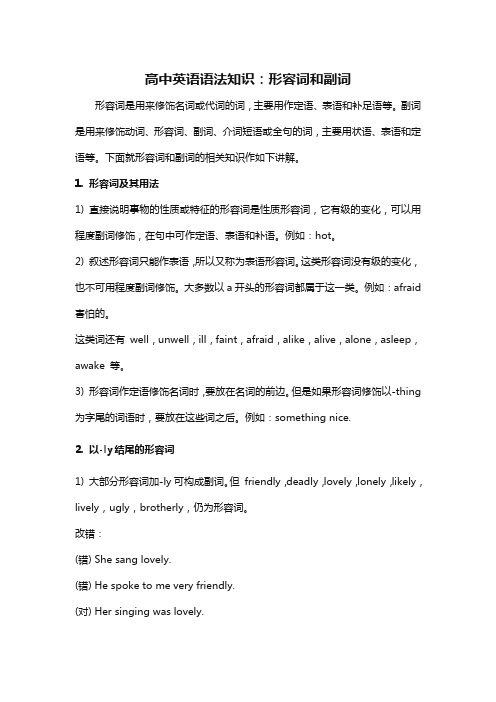
高中英语语法知识:形容词和副词形容词是用来修饰名词或代词的词,主要用作定语、表语和补足语等。
副词是用来修饰动词、形容词、副词、介词短语或全句的词,主要用状语、表语和定语等。
下面就形容词和副词的相关知识作如下讲解。
1. 形容词及其用法1) 直接说明事物的性质或特征的形容词是性质形容词,它有级的变化,可以用程度副词修饰,在句中可作定语、表语和补语。
例如:hot。
2) 叙述形容词只能作表语,所以又称为表语形容词。
这类形容词没有级的变化,也不可用程度副词修饰。
大多数以a开头的形容词都属于这一类。
例如:afraid 害怕的。
这类词还有well,unwell,ill,faint,afraid,alike,alive,alone,asleep,awake 等。
3) 形容词作定语修饰名词时,要放在名词的前边。
但是如果形容词修饰以-thing 为字尾的词语时,要放在这些词之后。
例如:something nice.2. 以-ly结尾的形容词1) 大部分形容词加-ly可构成副词。
但friendly,deadly,lovely,lonely,likely,lively,ugly,brotherly,仍为形容词。
改错:(错) She sang lovely.(错) He spoke to me very friendly.(对) Her singing was lovely.(对) He spoke to me in a very friendly way.2) 有些以-ly 结尾既为形容词,也为副词,如daily,weekly,monthly,yearly,early等。
例如:The Times is a weekly paper. 《时代周刊》为周刊。
The Times is published weekly. 《时代周刊》每周发行一期。
3. 用形容词表示类别和整体1) 某些形容词加上定冠词可以泛指一类人,与谓语动词的复数连接,如the dead,the living,the rich,the poor,the blind,the hungry等。
高中英语语法:形容词和副词(共61张PPT)

一、形容词和副词的句法功能
1.作定语 形容词作定语一般位于被修饰词的前面;副词作定语多表示时间 或地点,位于被修饰词的后面。 Widespread poverty in Africa means that many people there cannot get the water, clothing, housing, electricity, or education they need.非 洲普遍的贫穷意味着那里的许多人不能获得他们需要的饮用水、 衣服、房屋、电力及教育。 The people there were friendly.那儿的人很友好。(副词作定语须 后置)
the English英国人
(2)“the+形容词”表示抽象概念,作主语时谓语动词用单数。
the best最好的情况
the unknown未知的事
the impossible不可能的事
the right正确的事
二、形容词和副词的位置
1.形容词的位置 (1)一般情况下,单个形容词都位于所修饰的名词前。
一二、介 形词 容的 词分 和类副词的位置
(3)形容词也可位于被修饰名词之后。
③两个意义相近或相反的形容词用and, or或but连接,作定语时须后 置。 Power stations, large or small, have been set up all over the country.大大 小小的发电站已经在全国建立起来了。 All the people on this island, young or old, are fond of music.这个岛上的 老老少少都喜欢音乐。(意义相反。) ④当“形容词+不定式”构成的短语作定语时。 A man so difficult to please must be hard to work with.一个如此难以取悦 的人一定很难共事。 He enjoys the music pleasant to listen to.他很喜欢这首听起来很好听的 音乐。
高中英语2025届高考语法复习形容词与副词知识讲解
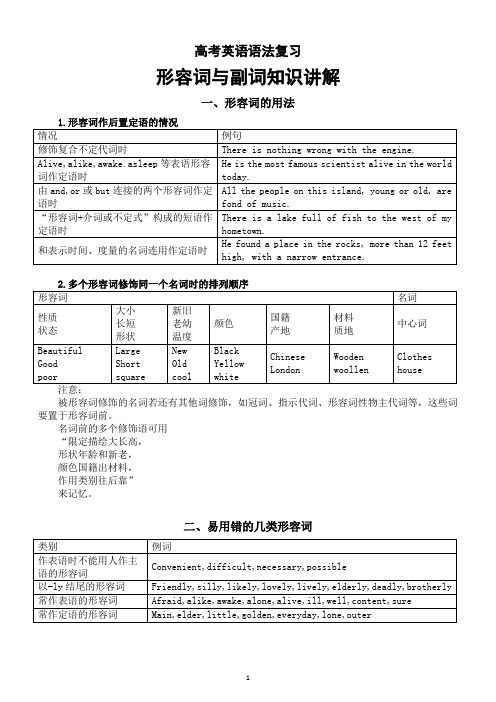
高考英语语法复习
形容词与副词知识讲解
一、形容词的用法
被形容词修饰的名词若还有其他词修饰,如冠词、指示代词、形容词性物主代词等,这些词要置于形容词前。
名词前的多个修饰语可用
“限定描绘大长高,
形状年龄和新老,
颜色国籍出材料,
作用类别往后靠”
来记忆。
二、易用错的几类形容词
三、形容词的比较等级
English is as interesting a subject as Chinese.
Which is the better of the two watches?
She is the taller of the two girls.
other或else把主语排除在比较对象之外;但如果不在同一范围比较则不需要用。
Susan is taller than any girl in her sister’s class.
四、副词的句法功能
五、副词的位置
六、副词比较等级的用法。
高中英语语法系统讲解之四形容词和副词

高中英语语法系统讲解之四形容词和副词形容词和副词形容词一. 形容词的语法功能形容词用来修饰名词或代词,表示人或事物的性质、状态或特征。
在句中作定语、表语、宾语补足语以及状语。
形容词前加定冠词the,相当于一个名词。
如He is a young Russian soldier. The film is interesting.He likes to paint the wall pink. Lucy came to the party, happy.The blind are taught how to do the work.温馨提示:1. 有些形容词通常作表语和补语,不能像普通形容词那样作前置定语,这样的形容词称为表语形容词。
如alive, alone, asleep, alike, afraid, awake, ashamed, able, sure, ill, worth等;其作定语时后置。
2. 有些形容词只能作定语,不能作表语,这样的形容词称为定语形容词,如golden, wooden, silken, live, elder, former, latter, front, back, outer等二. 形容词的分类1. 性质形容词○1外观:long, strong, big, round, fat, beautiful, old等○2性质:good, clean, new, fresh, soft, excellent等○3颜色:red, black, green, blue, white, brown等○4情绪:happy, sad, sorry, nervous, anxious等○5性格:kind, cruel, honest, foolish, lazy, rude等○6状况:careful, blind, deaf, cheap, hungry等○7评论:great, true, necessary, difficult, wrong等2. 关系形容词○1地域:Chinese, American, Asian, Pacific 等○2质料:wooden, golden, plastic, metallic 等○3科技:electric, chemical, atomic,medical等○4意识:communist, social, political, religious等○5行业:industrial, agricultural, economic, military等三. 形容词在句中的位置1. 单个形容词作定语时,一般放在被修饰的名词之前;两个或两个以上的形容词修饰一个名词时,同种类形容词的排列顺序一般应考虑以下两种情况:○1和被修饰的名词关系比较密切的形容词位置更靠近名词。
高中英语高考语法复习形容词与副词

高考英语形容词与副词一、形容词01 形容词的句法功能02 形容词的位置形容词作定语时一般置于被修饰词前作前置定语,下列情况中形容词通常后置于被修饰词。
(1)修饰something,anybody,nobody,anything等复合不定代词时There is nothing wrong with the machine.(机器什么问题都没有。
)(2)形容词词组作定语时She bought a book suitable for children.(她买了本适合孩子们的图书。
)(3)修饰表示数量的词要后置The baby is only five months old.(这个婴儿仅有五个月大。
)(4)enough作形容词修饰名词时,一般放在名词之前,也可放在名词之后We don't bring enough money.(我们没带够钱。
)There‘ll be time enough to relax when you’ve finished your work.(你完成工作后会有足够的时间来放松。
)[注]形容词常见于定语位置和表语位置,以上只列出几种常见情况讲解。
具体位置要视具体形容词及句子而定。
03 多个形容词修饰名词时的语序按以下顺序排列:(1)限定词(a/an,the,this,his,first,one...)(2)表示特征或性质等描述性形容词(good,pretty...)(3)表示大小、长短、高低的形容词(big,long,little...)(4)表示形状的形容词(round,square...)(5)表示年龄、新旧的形容词(old,young,new...)(6)表示颜色的形容词(red,yellow...)(7)表示国籍、地区、出处的形容词(America,southern,Italian...)(8)表示物质材料的形容词(wooden,woollen,glass...)(9)表示用途、类别的形容词(medical,writing...)a beautiful large green Chinese carpet一块漂亮宽大的绿色的中国地毯the first three days 头三天enormous black iron gates 巨大的黑色铁门04 形容词的特殊用法二、副词01 副词的种类根据词义可分为:(1)时间副词yesterday(昨天),today(今天),now(现在)等。
高中英语语法复习专题讲解形容词副词
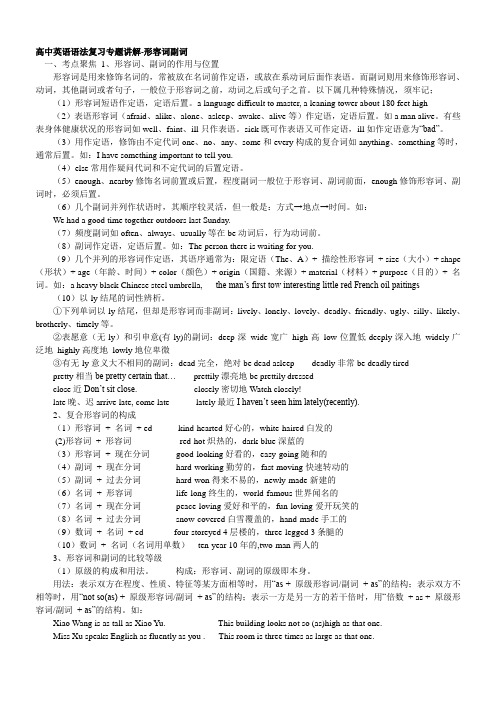
高中英语语法复习专题讲解-形容词副词一、考点聚焦1、形容词、副词的作用与位置形容词是用来修饰名词的,常被放在名词前作定语,或放在系动词后面作表语。
而副词则用来修饰形容词、动词,其他副词或者句子,一般位于形容词之前,动词之后或句子之首。
以下属几种特殊情况,须牢记;(1)形容词短语作定语,定语后置。
a language difficult to master, a leaning tower about 180 feet high(2)表语形容词(afraid、alike、alone、asleep、awake、alive等)作定语,定语后置。
如a man alive。
有些表身体健康状况的形容词如well、faint、ill只作表语。
sick既可作表语又可作定语,ill如作定语意为“bad”。
(3)用作定语,修饰由不定代词one、no、any、some和every构成的复合词如anything、something等时,通常后置。
如:I have something important to tell you.(4)else常用作疑问代词和不定代词的后置定语。
(5)enough、nearby修饰名词前置或后置,程度副词一般位于形容词、副词前面,enough修饰形容词、副词时,必须后置。
(6)几个副词并列作状语时,其顺序较灵活,但一般是:方式→地点→时间。
如:We had a good time together outdoors last Sunday.(7)频度副词如often、always、usually等在be动词后,行为动词前。
(8)副词作定语,定语后置。
如:The person there is waiting for you.(9)几个并列的形容词作定语,其语序通常为:限定语(The、A)+ 描绘性形容词+ size(大小)+ shape (形状)+ age(年龄、时间)+ color(颜色)+ origin(国籍、来源)+ material(材料)+ purpose(目的)+ 名词。
高中英语语法大全之形容词和副词
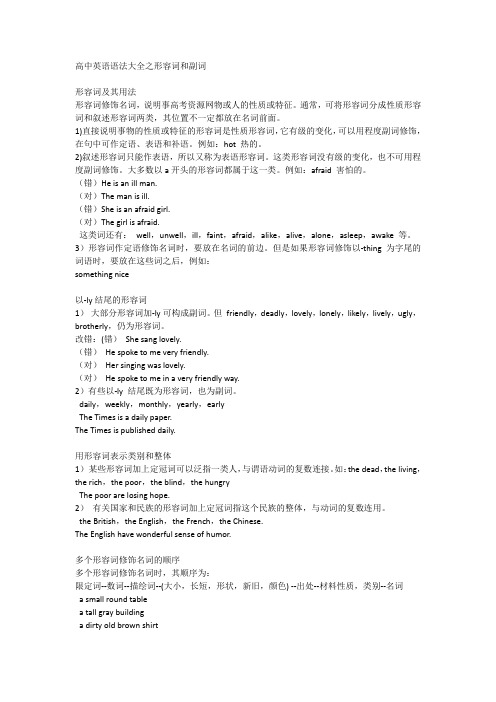
高中英语语法大全之形容词和副词形容词及其用法形容词修饰名词,说明事高考资源网物或人的性质或特征。
通常,可将形容词分成性质形容词和叙述形容词两类,其位置不一定都放在名词前面。
1)直接说明事物的性质或特征的形容词是性质形容词,它有级的变化,可以用程度副词修饰,在句中可作定语、表语和补语。
例如:hot 热的。
2)叙述形容词只能作表语,所以又称为表语形容词。
这类形容词没有级的变化,也不可用程度副词修饰。
大多数以a开头的形容词都属于这一类。
例如:afraid 害怕的。
(错)He is an ill man.(对)The man is ill.(错)She is an afraid girl.(对)The girl is afraid.这类词还有:well,unwell,ill,faint,afraid,alike,alive,alone,asleep,awake 等。
3)形容词作定语修饰名词时,要放在名词的前边。
但是如果形容词修饰以-thing为字尾的词语时,要放在这些词之后,例如:something nice以-ly结尾的形容词1)大部分形容词加-ly可构成副词。
但friendly,deadly,lovely,lonely,likely,lively,ugly,brotherly,仍为形容词。
改错:(错)She sang lovely.(错)He spoke to me very friendly.(对)Her singing was lovely.(对)He spoke to me in a very friendly way.2)有些以-ly 结尾既为形容词,也为副词。
daily,weekly,monthly,yearly,earlyThe Times is a daily paper.The Times is published daily.用形容词表示类别和整体1)某些形容词加上定冠词可以泛指一类人,与谓语动词的复数连接。
- 1、下载文档前请自行甄别文档内容的完整性,平台不提供额外的编辑、内容补充、找答案等附加服务。
- 2、"仅部分预览"的文档,不可在线预览部分如存在完整性等问题,可反馈申请退款(可完整预览的文档不适用该条件!)。
- 3、如文档侵犯您的权益,请联系客服反馈,我们会尽快为您处理(人工客服工作时间:9:00-18:30)。
举例:
1.Chinese, glass, a, beautiful, table a beautiful Chinese glass table
2.wonderful, my, garden, new, large my wonderful large new garden
3. a, round, table, small a small round table
形容词和副词
形容词
❖ 形容词修饰名词,说明事物或人的性质或特征。
形容词
性质形容词
叙述形容词
❖直接说明事物的性质或特征的形容词是性 质形容词,它有级的变化,可以用程度副 词修饰,在句中可作定语、表语和补语。
❖例如:hot
Today is very hot.
It’s a hபைடு நூலகம்t day.
❖叙述形容词只能作表语,所以又称为表语形 容词。这类形容词没有级的变化,也不可用 程度副词修饰。大多数以a开头的形容词都 属于这一类。
Everyone, young or old, will do it.
❖(5) 表示方位、时间和数量等习语、词组连用时后置
This is a river two hundred miles long.
It is a bridge eight metres wide.
❖(二)作表语
❖1.在连系动词后要用形容词作表语:常见的 连系动词有:be,look,feel,smell,taste ,sound,get/become/grow,remain, 而 行为动词则要用副词修饰。
形容词的功能及位置:
❖ (一)作定语
❖ 1.前置定语 ❖ (1)形容词作定语一般需放在它所修饰的名
词之前并尽量靠近被修饰的词。在这种位置上 的定语叫前置定语。语序一般为“冠词(或其 他限定词)+形容词+名词”。 He is an honest boy.
❖ (2)若有多个形容修饰名词,它们的位置要由它们与 被修饰词的密切程度来决定。其排列顺序通常是:( 县官行令杀国材)
The cake tastes delicious. He looks very tired.
❖2.只能用作表语的形容词:大多数形容词可 以用作定语或表语,但有些形容词只能用作 表语。
❖(1)以“a-”开头的形容词和content, ill, drunk, sure, liable, unable, well等词。
❖ 限定词+描绘性形容词+大小+形状+新旧+颜色+国籍 、地区+表材料质地的形容词+名:
❖ 县,即“限”,指限定词,如:the; a/an; this; that; your; my; ❖ 官,即“观”,指观点或评价性词,如:lovely; interesting;
cute ❖ 行,即“形”,指形状大小,如:large; big; small; little; round; ❖ 令,即“龄”,指年龄及新旧,如:new; old; ancient; old… ❖ 杀,即“色”,指颜色,如:red; green; orange; brown… ❖ 国,指国家或出处,如:Chinese; Japanese; home-made… ❖ 材,指材料,也就是用什么做的。如:glass; stone; wood
She is asleep now. The film is worth seeing.
❖ (2)有些形容词是以-ly结尾的,我们容易把它们误 认为是副词,如lovely,friendly,orderly, motherly, lonely,likely,lively,ugly:
(错) He spoke to me very friendly. (对) He spoke to me in a very friendly way. ❖但有些以-ly 结尾既为形容词,也为副词,如daily,
答案A. 年龄+国家+材料。
❖2.后置定语
❖ (1)作不定代词的定语 ❖修饰someone, something, anyone, anything,
nobody everyone, nothing, no one, 等不定代词时, 要后置。
There is nothing new.
She must have met something dangerous. ❖ (2)前缀以a-构成的形容词作定语时要求后置。 ❖ 常见的有afraid, alive, alike, asleep, awake等
4. a, old, dirty, brown shirt a dirty old brown shirt
❖练习:
Tony is going camping with ______ boys. A. little two other B. two little other C. two other little D. little other two
The man awake at that time was Mr. Smith.
❖ (3)形容词短语作定语时要后置。这些形容词短语多 是由 “形容词+介词短语/不定式短语”构成。
It is a problem difficult to solve.
❖ (4)形容词成对使用时,由and/or连接的并列形容词 成对使用时后置。
weekly,monthly,yearly,early等: The Times is a weekly paper. The Times is published weekly.
答案:C. 由\“限定词--数词--描绘
One day they crossed the ____bridge behind the palace. A. old Chinese stone B. Chinese old stone C. old stone Chinese D. Chinese stone old
❖如,afraid
错: He is an ill man.
对:The man is ill.
错: She is an afraid girl.
对:The girl is afraid.
这类词还有: well,unwell,ill,faint, afraid,alike,alive,alone,asleep, awake
